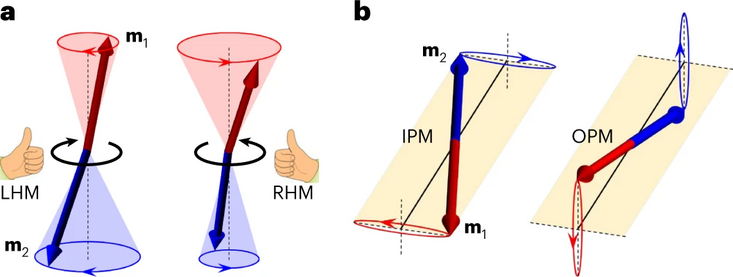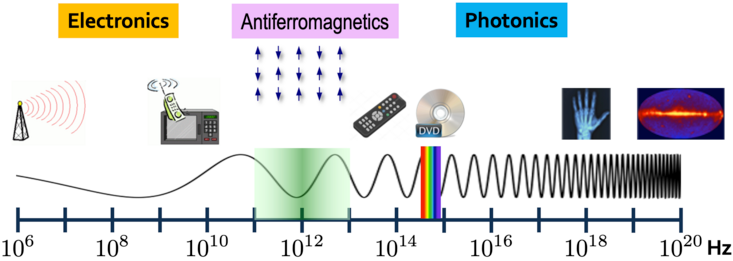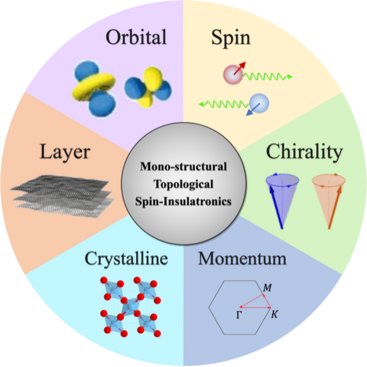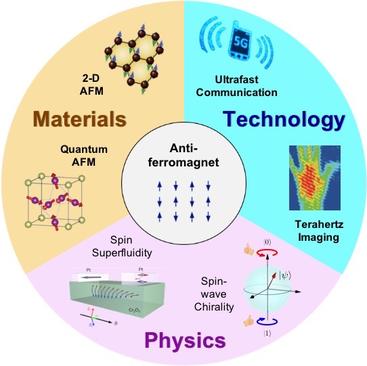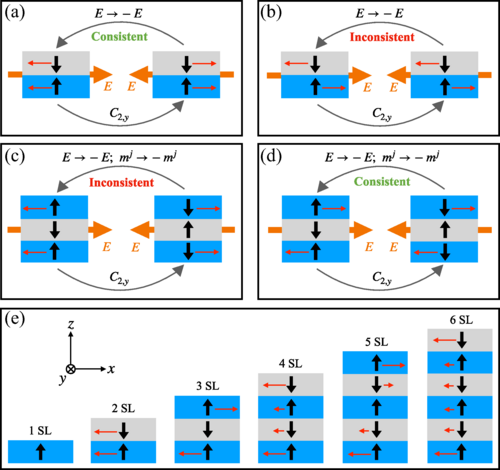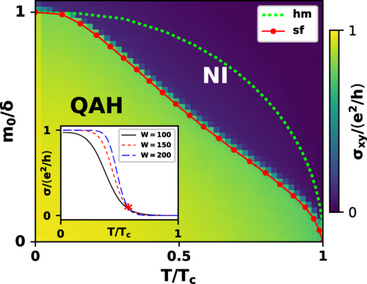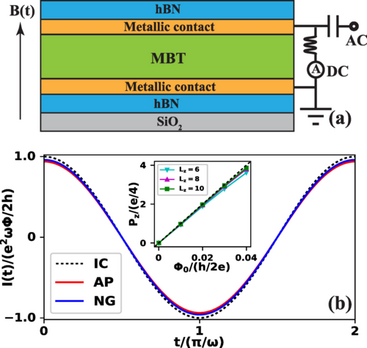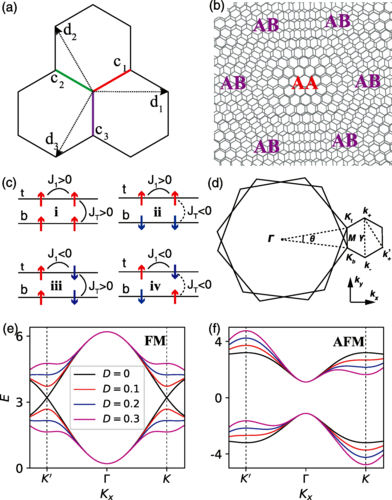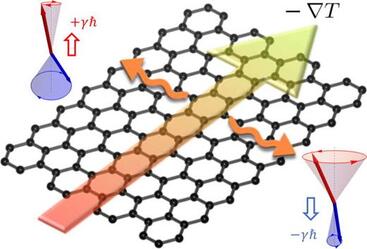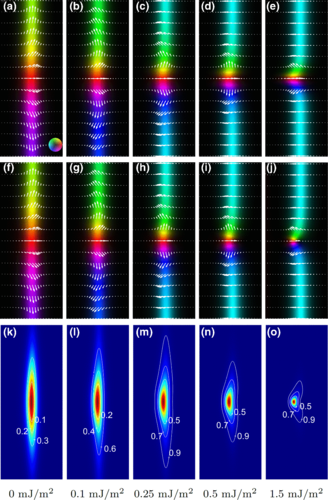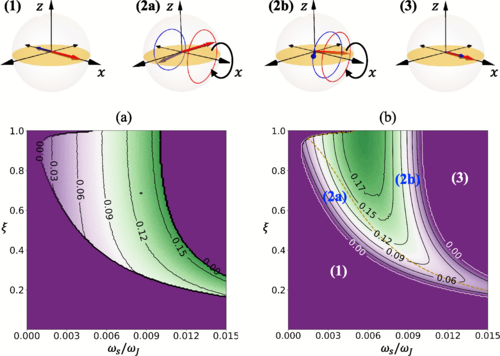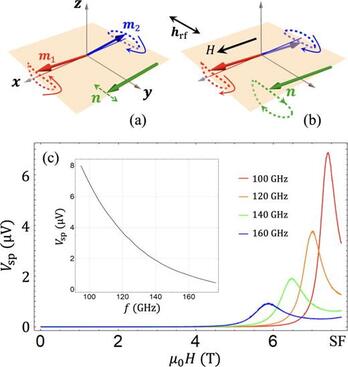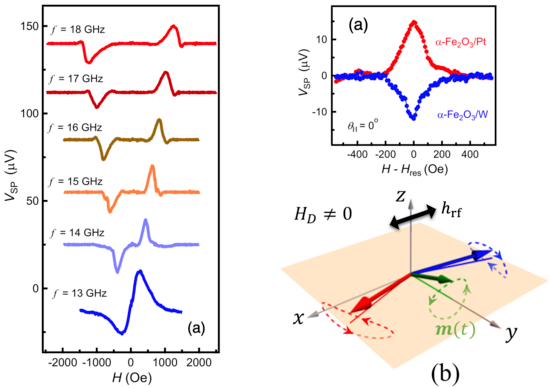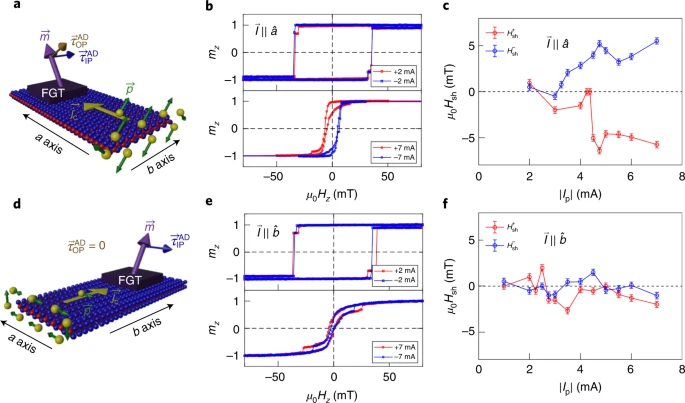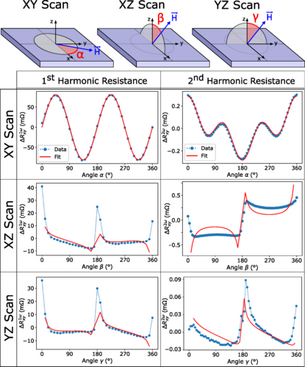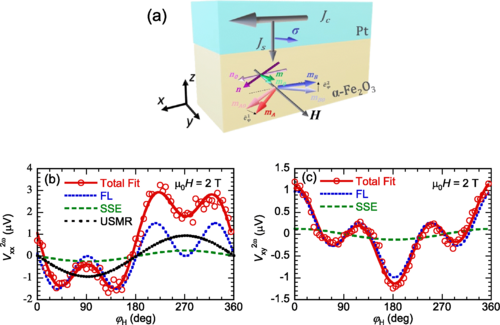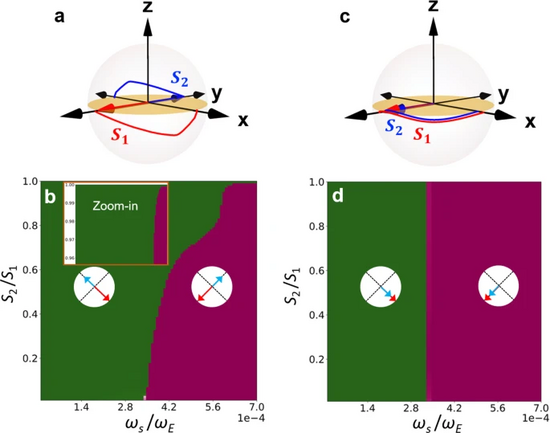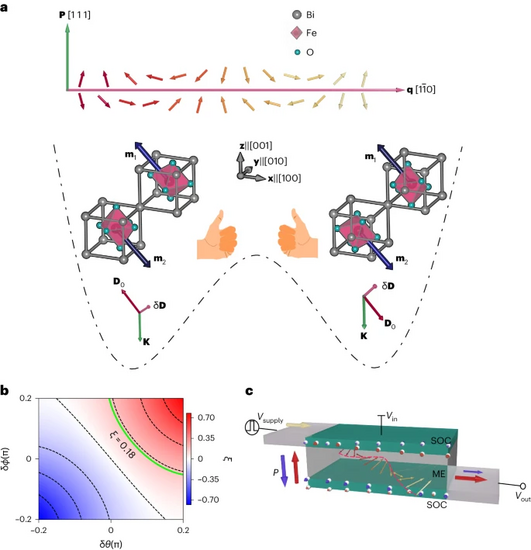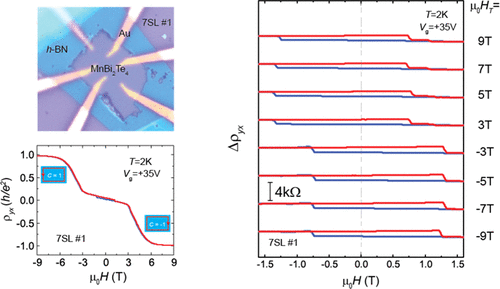General Information
Antiferromagnetic Magnonics
Quantum spin-wave excitations (dubbed magnons) are charge neutral quasiparticles that can carry and transmit spin angular momenta without physical movements of electrons, hence eliminating Joule heating. Magnetic insulators can then function as "metals" to conduct spins while blocking charges. A unique feature of antiferromagnetic magnons is that they have two spin species that can form an internal degree of freedom capable of encoding information.
Antiferromagnetic Spintronics
Antiferromagnets (AFMs) can be operated in the ultrafast terahertz regime (1012 Hz, about 2 to 3 orders of magnitude faster than ferromagnets) by virtue of the "amplification" of the strong exchange interaction. In addition, AFMs have vanishing macroscopic magnetization so that they do not produce stray fields and are insensitive to magnetic perturbations.
Monostructural Topological Spin-Insulatronics
A prevailing pursuit of spintronics is to effectively control magnetism through electrical stimuli, which is exemplified by a heterostructure composed of a magnet and a non-magnetic driver operated by electric currents. This archetypal setup, however, suffers strong Joule heating and interfacial inhibition of spin delivery, rendering the overall efficiency surprisingly low.
-
We propose a new paradigm that fundamentally resolves the above prevailing issues by exploring dissipationless spintronics based on a single material that is able to drive itself without relying on external materials.
-
The discovery of intrinsic magnetic topological insulators opened a unique physical platform to explore the new paradigm we proposes.
-
Spin generation and transfer processes no longer reply on Ohm's currents but are instead enabled by the adiabatic currents arising from the Berry curvature that entangles multiple degrees of freedom.
Physics-Enabled Novel Applications
It is an appealing development in spintronics to recognize AFMs as promising candidate materials for future device applications. AFMs can potentially lead to transformative technological advances because of the their salient physical features.
-
Terahertz: Ultrafast terahertz operations of AFMs arise from unique physics rather than smart designs, holding huge potential to break the theoretical limit of ferromagnet-based electronics.
-
Spin: AFMs support magnons of opposite spin polarizations. This unique degree of freedom enables magnons to serve as active information carriers.
-
Robustness: Macroscopic magnetization vanishes in most AFMs, so AFM-based devices are free from stray fields, hence the crosstalk, between adjacent memory units.
Recent Research Highlights
Stand-alone theoretical studies
Are there any subtle relations among non-Hermitian quantum systems, electromagnetism, and special relativity? This question entails profound and intriguing physics.
We reveal a hidden electrodynamical structure emerging from a general 2×2 pseudo-Hermitian system that exhibits real spectra. Even when the Hamiltonian does not explicitly depend on time, the Berry curvature can be mapped onto a (2+1)-dimensional electromagnetic field arising from an artificial spacetime instanton (a point-like topological defect), in sharp contrast to the Hermitian systems where the Berry curvature is equivalent to the static magnetic field of a magnetic monopole in three spatial dimensions. The instanton appearing as a spacetime singularity carries a topological charge that quantizes the jump of magnetic flux of the Berry curvature at the time origin. Our findings are demonstrated in a simple example related to antiferromagnetic magnons.
Ref: Phys. Rev. Lett. 135, 126609 (2025)
 In solid-state systems, symmetry and interactions can directly manifest in the properties of quasiparticles by affecting the momentum-space topology. But what's the impact of real-space topology?
In solid-state systems, symmetry and interactions can directly manifest in the properties of quasiparticles by affecting the momentum-space topology. But what's the impact of real-space topology?
We propose a mechanism of topology-induced symmetry breaking, where certain local symmetry preserved by the Hamiltonian is explicitly broken in the eigenmodes of excitation due to nontrivial real-space topology. We demonstrate this phenomenon by studying magnonic excitations on a Möbius strip comprising two antiferromagnetically coupled spin chains. Even with a simple Hamiltonian respecting local rotational symmetry, with all local curvature effects ignored, magnons exhibit linear polarization of the Néel vector devoid of chirality, forming two non-degenerate branches that cannot be smoothly connected to nor globally decomposed into, the circularly-polarized magnons. Correspondingly, one branch undergoes a spectral shift and only admits standing waves of half-integer wavelength, whereas the other only affords standing waves of integer wavelength. Under the Möbius boundary condition, we further identify an exotic phase hosting spontaneous antiferromagnetic order whilst all exchange couplings are ferromagnetic. The suppression of chirality in the order parameter dynamics, hence the pattern of standing waves, can be generalized to other elementary excitations on non-orientable surfaces. Our findings showcase the profound influence of real-space topology on the physical nature of not just the ground state but also the quasiparticles.
Ref: SciPost Phys. 19, 048 (2025)
 Changing the magnetic ordering can alter the electronic structures in magnetic topological materials. What about the inverse control? Namely, can we generate and control magnetic dynamics via topological electrons?
Changing the magnetic ordering can alter the electronic structures in magnetic topological materials. What about the inverse control? Namely, can we generate and control magnetic dynamics via topological electrons?
We extend the Kane-Mele model to include the exchange coupling to a collinear antiferromagnetic (AFM) order, which allows the system to exhibit the quantum anomalous Hall and quantum spin Hall effects in the absence of a net magnetization. These topological phases support a staggered Edelstein effect through which an applied electric field can generate opposite non-equilibrium spins on the two AFM sublattices, realizing the Néel-type spin-orbit torque (NSOT). Contrary to known NSOTs in AFM metals driven by conduction currents, our NSOT arises from pure adiabatic currents devoid of Joule heating, while being a bulk effect not carried by the edge currents. By virtue of the NSOT, the electric field of a microwave can drive the AFM resonance with a remarkably high efficiency, outpacing the magnetic field-induced AFM resonance by orders of magnitude in terms of power absorption.
Ref: Nature Comm. 16:7790 (2025)
Can you imagine operating a device with 100% mechanical efficiency, namely no energy is wasted on heating? Don't take me wrong, I'm not referring to the perpetual machine, seriously! This is the "adiabatic quantum machine". But, what the hell is it?
In PRL 132, 136701 (2024), we theoretically propose a lossless spin-orbit torque (SOT) and its inverse effect, adiabatic charge pumping, in MnBi2Te4 of a few septuple-layer (SL) thick. The SOT is manifestly SL resolved and displays an evident even-vs-odd contrast of the (total) SL number. The physical consequences of the SOT are demonstrated by the SOT-induced magnetic resonances, where in the 3-SL case we identify a unique chiral mode that is blind to microwave electromagnetic fields but can be excited only by the SL-resolved SOT.
In contrast to conventional SOTs, the SOT in MnBi2Te4 is not accompanied by Ohm’s conduction under the charge-neutral condition. In our scenario, the output current only originates from the dynamics of magnetic moments as a reciprocal effect of the SOT, which is a purely adiabatic, producing zero Joule heating. Under the combined action of the SOT and its reciprocal process, a voltage-driven MnBi2Te4 acquires an effective reactance, whereby 100% of the input electric power can be converted into magnetic dynamics to overcome the Gilbert damping, achieving an unprecedented high efficiency of electrical manipulation of magnetism using a single material.
Ever wonder if topological phases are really that robust as you were once told?
In PRL 126, 026601 (2021), we show that considering the exchange gaps at the mean-field level is inadequate to predict phase transitions between electronic states of distinct topology. Thermal spin fluctuations disturbing the magnetization can act as frozen disorders that strongly scatter electrons, appreciably reducing the onset temperature of quantized transport even in the absence of structural impurities. This counterintuitive effect, which has hitherto been overlooked, provides an alternative explanation to several recent experiments on magnetic topological insulators.
The unique mechanism studied in this work is entirely different from the ordinary magnon-electron scattering. First of all, we have considered the adiabatic regime such that spin fluctuations are frozen in time, whereas magnons are propagating spin waves. Second, spin fluctuations form a background random potential that scatters the electrons passively, while reversely, the excitation of spin fluctuations by electrons is ignored. Third, the physical picture of spin fluctuations persists up to Tc, whereas magnons are well defined only at low temperatures. In addition, the mechanism here is intrinsic and independent of structure impurities.
The intrinsic magnetic topological insulator MnBi2Te4 is believed to be an axion insulator in its antiferromagnetic ground state. However, the direct identification of axion insulators remains experimentally elusive because the observed vanishing Hall resistance, while indicating the onset of the topological axion field, is inadequate to distinguish the system from a trivial normal insulator.
In PRR 4, L022067 (2022) , we propose an axion-insulator magnetic tunnel junction (AMTJ) consisting of a few-layer MnBi2Te4 sandwiched between two metallic contacts as an experimental setup to unambiguously identify axion insulators through the quantized topological magnetoelectric effect. Using numerical Green's functions, we theoretically demonstrate the quantized magnetoelectric current in the proposed AMTJ, which can serve as a smoking-gun signal to unambiguously confirm axion insulators. Our predictions have inspired a series of experimental attempts.
For an sample of lateral size Lx = Ly = 10 µm, a harmonic magnetic field of strength B ~ 100 Gs and frequency ω/2π = 1 GHz induces an output ac current of amplitude 121.5 nA, which is a significant effect easy to detect.
Exotic physics in twisted bilayer 2D materials is a surging frontier in condensed matter physics. However, prevailing studies predominantly focus on the electronic structures associated with the moiré pattern while the hidden roles of phonons and magnons are largely overlooked.
In PRB 102, 094404 (2020), we perform an in-time and in-depth investigation of the moiré magnons in twisted bilayer 2D magnets, assuming that the out-of-plane collinear magnetic order is preserved under weak interlayer coupling. By calculating the magnonic band structures and the topological Chern numbers for four representative cases, we find:
- The valley moiré bands are extremely flat over a wide range of continuous twist angles
- The topological Chern numbers of the lowest few flat bands vary significantly with the twist angle
- The lowest few topological flat bands in bilayer AFMs enable nontrivial thermal spin transport in the transverse direction
These properties make twisted bilayer magnets an ideal platform to study the magnonic counterparts of moiré electrons, where the statistical distinction between magnons and electrons plays a critical role.
Can magnons enjoy the same level of physical significance as electrons? What phenomena could they bring about?
Magnons in AFMs and their physical implications have helped facilitate the emergence of novel device concepts. A unique characteristic of antiferromagnetic magnons is the coexistence of opposite spin polarization, which mimics the electron spin in a variety of transport phenomena. Among them, the most prominent spin-contrasting phenomenon is the magnon spin Nernst effect (SNE), which refers to the generation of a transverse pure magnon spin current through a longitudinal temperature gradient. The magnon SNE can be intuitively regarded as the magnonic counterpart of the spin-Hall effect. In APL 120, 090502 (2022), we introduce selected recent progress in the study of magnon SNE with focus on its underlying physical mechanisms. In a related study published in PR Applied 16, 034035 (2021), we critically examined the physical challenges obstructing the electronic detection of the magnon SNE, suggesting that optical measurements should be more reliable to experimentally verify this effect.
You must have heard of various topological defects in magnets, but have you ever heard of a "defect on a defect"?
It is well established that the spin-orbit interaction in heavy metal/ferromagnet heterostructures leads to a significant interfacial Dzyaloshinskii-Moriya interaction (DMI), which modifies the internal structure of magnetic domain walls (DWs) to favor Néel- over Bloch-type configurations. However, the impact of such a transition on the structure and stability of internal DW defects (e.g., vertical Bloch lines) awaits exploration. In PRB 99, 184412 (2019), we present an integrated analytical-micromagnetic study to describe a type of topological excitation called DW skyrmion characterized by a 360° rotation of the internal magnetization in a Dzyaloshinskii DW. We further propose a method to identify DW skyrmions experimentally using Fresnel-mode Lorentz transmission electron microscopy; simulated images of DW skyrmions using this technique are presented based on the micromagnetic results.
Although open questions remain about their thermal stability and dynamic properties, DW skyrmions provide an alternative strategy for leveraging topological protection in magnetic systems with a strong interfacial DMI. The reconfigurable nature of the DWs that host these excitations could open the door to different kinds of memory and computing schemes based on topological charge.
Collaborating groups led by: Vincent Sokalski & Marc De Graef (CMU), Claudia Mewes & Tim Mewes (Univ Alabama)
You can name numerous distinctions between ferromagnets and antiferromagnets, but can you navigate between these two limits in a continuous manner?
Ferrimagnets (FIMs) can function as high-frequency AFMs while being easy to detect as ferromagnets, offering unique opportunities for ultrafast device applications. While the physical behavior of FIMs near the compensation point has been widely studied, there lacks a generic understanding of FIMs where the ratio of sublattice spins can vary freely between the ferromagnetic and antiferromagnetic limits. In PRB 105, 064410 (2022), we investigate the physical properties of a two-sublattice FIM manipulated by static magnetic fields and current-induced torques. By continuously varying the ratio of sublattice spins, we clarify how the dynamical chiral modes in a FIM are intrinsically connected to their ferro- and antiferromagnetic counterparts, which reveals unique features not visible near the compensation point. In particular, we find that current-induced torques can trigger spontaneous oscillation of the terahertz exchange mode. Compared with its realization in AFMs, a spin-torque oscillator using FIMs not only has a reduced threshold current density but also can be self-stabilized, obviating the need for dynamic feedback.
True story: I used to believe (and also told my colleagues) that NiO, a prototype easy-plane AFM, cannot be used for coherent spin pumping...... until I disapproved myself. What happened?
Spin pumping converting sub-terahertz electromagnetic waves to DC spin currents has recently been demonstrated in AFMs with easy-axis magnetic anisotropy such as MnF2 and Cr2O3. However, easy-plane AFMs such as NiO, which are easier to prepare experimentally, are considered to be bad candidates for spin pumping because the Néel vector oscillation is linearly polarized, placing a major restriction on the material choice for practical applications. Through a case study of NiO in APL 121, 072401 (2022) , we show that an applied magnetic field below the spin–flop transition can substantially modify the polarization of the resonance eigenmodes, which enables coherent sub-terahertz spin pumping as strong as that in easy-axis AFMs. In addition, we find that an applied magnetic field can significantly reduce the threshold of Néel vector auto-oscillation triggered by spin-transfer torques. These prominent field-assisted effects can greatly facilitate spintronic device engineering in the sub-terahertz frequency regime.
This work was partially inspired by the experimental realization of spin pumping in a canted easy-plane AFM (details can be found below), and as a matter of fact, challenged the seemingly established picture that "spin pumping does not work for easy-plane AFMs" we previously argued in PRL 2014. Indeed, scientific progress is always built on overturning previous conclusions.
Collaborative studies with experimentalists
Through two independent experiments using different materials (MnF2: Science 2020 and Cr2O3: Nature 2020), which corroborate each other, my theoretical prediction of the terahertz spin pumping in AFM had been verified experimentally, marking a major breakthrough in the field of antiferromagnetic spintronics.
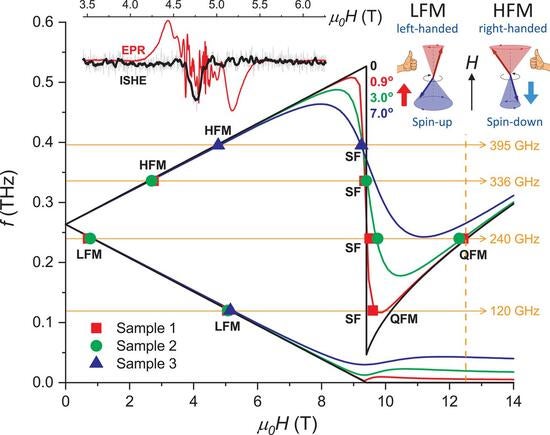
Collaborating groups led by:
Enrique Del Barco (UCF), David Lederman (UCSC),
Johan van Tol (FSU), Arne Brataas (NTNU)
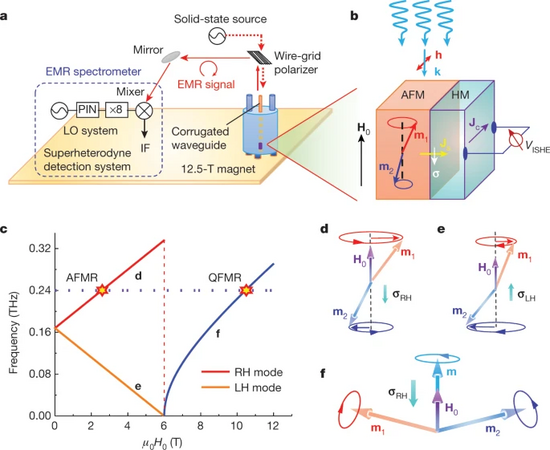
Collaborating groups led by:
Jing Shi (UCR), Mark Sherwin (UCSB), Peng Wei (UCR)
The realization of sub-terahertz spin pumping in AFMs inspired a flurry of experiments worldwide, including a collaboration between our group and the former Nanoscale Quantum Sensing group at UCSD. In PRL 127, 117202 (2021), we report dc spin pumping by the acoustic resonant mode in a canted easy-plane antiferromagnet 𝛼−Fe2O3 enabled by the Dzyaloshinskii–Moriya interaction. Systematic angle and frequency-dependent measurements demonstrate that the observed spin-pumping signals arise from resonance-induced spin injection and inverse spin Hall effect in 𝛼−Fe2O3—metal heterostructures, mimicking the behavior of spin pumping in conventional ferromagnet-nonmagnet systems. The pure spin current nature is further corroborated by reversal of the polarity of spin-pumping signals when the spin detector is switched from platinum to tungsten which has an opposite sign of the spin Hall angle. Our results reveal the intriguing physics underlying the low-frequency spin dynamics and transport in canted easy-plane antiferromagnet-based heterostructures.
Collaborating groups led by: Chunhui Du (UCSD)
SOT-driven deterministic control of the magnetic state of a ferromagnet with perpendicular magnetic anisotropy is key to next-generation spintronic applications including non-volatile, ultrafast and energy-efficient data-storage devices. However, field-free deterministic switching of perpendicular magnetization remains a challenge because it requires an out-of-plane antidamping torque, which is not allowed in conventional spin-source materials such as heavy metals and topological insulators due to the system’s symmetry. The exploitation of low-crystal symmetries in emergent quantum materials offers a unique approach to achieve SOTs with unconventional forms. In Nature Mater. 2022, we report field-free deterministic magnetic switching of a perpendicularly polarized van der Waals magnet employing an out-of-plane antidamping SOT generated in layered WTe2, a quantum material with a low-symmetry crystal structure. Our numerical simulations suggest that the out-of-plane antidamping torque in WTe2 is essential to explain the observed magnetization switching.
Major collaborating groups led by: Simranjeet Singh & Jyoti Katoch (CMU)
The effect of spin currents on the magnetic order of insulating AFMs is of fundamental interest and can enable new applications. Toward this goal, characterizing the SOTs associated with AFM–heavy metal interfaces is important. In PRL 2022, we report the full angular dependence of the harmonic Hall voltages in a predominantly easy-plane AFM, epitaxial c-axis oriented 𝛼−Fe2O3 films, with an interface to Pt. By modeling the harmonic Hall signals together with the 𝛼−Fe2O3 magnetic parameters, we determine the amplitudes of field-like and damping-like SOTs. Out-of-plane field scans are shown to be essential to determining the damping-like component of the torques. In contrast to ferromagnetic–heavy-metal heterostructures, our results demonstrate that the field-like torques are significantly larger than the damping-like torques, which we correlate with the presence of a large imaginary component of the interface spin-mixing conductance.
Our work demonstrates a direct way of characterizing SOTs in AFM-heavy metal heterostructures, opening up a promising path for future studies on similar AFM-HM heterostructures as well as a means that can be used in optimizing SOTs on AFM for applications.
Collaborating groups led by: Andrew Kent (NYU), Fengyuan Yang (OSU)
Unidirectional spin Hall magnetoresistance (USMR) has been widely reported in the heavy metal/ferromagnet bilayer systems. In PRL 2023, we report the observation of the USMR in Pt/𝛼−Fe2O3 bilayers where the 𝛼−Fe2O3 is an antiferromagnetic insulator. Systematic field and temperature dependent measurements confirm the magnonic origin of the USMR. The appearance of USMR is driven by the imbalance of creation and annihilation of AFM magnons by the SOT due to the thermal random field. However, unlike its ferromagnetic counterpart, theoretical modeling reveals that the USMR in Pt/𝛼−Fe2O3 is determined by the antiferromagnetic magnon number with a non-monotonic field dependence. Our findings extend the generality of the USMR which pave the ways for the highly sensitive detection of AFM spin state.
Collaborating groups led by: Kang Wang (UCLA), Fengyuan Yang (OSU)
Terahertz spin dynamics and vanishing stray field make AFMs the most promising candidate for the next-generation magnetic memory technology with revolutionary storage density and writing speed. However, owing to the extremely large exchange energy barriers, energy-efficient manipulation has been a fundamental challenge in AFMs. In Nature Comm. 2022, we report an electrical writing of antiferromagnetic orders through a record-low current density on the order of 106 A/cm facilitated by the unique AFM-FM phase transition in FeRh. By introducing a transient FM state via current-induced Joule heating, the SOT can switch the AFM order parameter by 90° with a reduced writing current density similar to ordinary FM materials. This mechanism is further verified by measuring the temperature and magnetic bias field dependences, where the X-ray magnetic linear dichroism (XMLD) results confirm the AFM switching besides the electrical transport measurement. Our findings demonstrate the exciting possibility of writing operations in AFM-based devices with a lower current density, opening a new pathway towards pure AFM memory applications.
Major collaborating groups led by: Kang Wang (UCLA)
It has long been speculated that multiferroic materials could bring unique physical properties, hence new functionalities, to electronic devices. For example, it is far from clear whether (and how) the multiferroicity could lead to unique control of spin transmission mediated by magnon excitations. In established approaches, magnons are mostly manipulated through magnetic dipoles (that is, by breaking time-reversal symmetry). In Nature Mater. 2024, we report a highly non-trivial experimental observation of chiral spin transport in multiferroic BiFeO3 and its control by reversing the ferroelectric polarization (that is, by breaking spatial inversion symmetry). The ferroelectrically controlled magnons show up to 18% modulation at room temperature. The spin torque that the magnons in BiFeO3 carry can be used to efficiently switch the magnetization of adjacent magnets, with a spin–torque efficiency comparable to the spin Hall effect in heavy metals. Utilizing such controllable magnon generation and transmission in BiFeO3, an all-oxide, energy-scalable logic is demonstrated composed of spin–orbit injection, detection and magnetoelectric control. Our observations open a new chapter of multiferroic magnons and pave another path towards low-dissipation nanoelectronics.
Major collaborating groups led by: Ramamoorthy Ramesh & Zhi Yao (UC Berkeley), Daniel Ralph (Cornell)
Magnetic topological materials with coexisting magnetism and nontrivial band structures exhibit many novel quantum phenomena, including the quantum anomalous Hall effect, the axion insulator state, and the Weyl semimetal phase. As a stoichiometric layered antiferromagnetic topological insulator, thin films of MnBi2Te4 show fascinating even–odd layer-dependent physics. In Nano Letters 2024, we report the observation of the Chern insulator state at high magnetic fields in a series of thin-flake MnBi2Te4 devices fabricated using stencil masks. Upon magnetic field training, a large exchange bias effect is observed in odd but not in even septuple layer (SL) devices. Through theoretical calculations, we attribute the even–odd layer-dependent exchange bias effect to the contrasting surface and bulk magnetic properties of MnBi2Te4 devices. Our findings reveal the microscopic magnetic configuration of MnBi2Te4 thin flakes and highlight the challenges in replicating the zero magnetic field quantum anomalous Hall effect in odd SL MnBi2Te4 devices.
Major collaborating groups led by: Cui-zu Chang (PSU)
Unidirectional magnetoresistance (UMR) in a bilayer heterostructure, consisting of a spin-source material and a magnetic layer, refers to a change in the longitudinal resistance on the reversal of magnetization and originates from the interaction of non-equilibrium spin accumulation and magnetization at the interface. Since the spin polarization of an electric-field-induced non-equilibrium spin accumulation in conventional spin-source materials is restricted to be in the film plane, the ensuing UMR can only respond to the in-plane component of magnetization. However, magnets with perpendicular magnetic anisotropy are highly desired for magnetic memory and spin-logic devices, whereas the electrical read-out of perpendicular magnetic anisotropy magnets through UMR is critically missing. In Nature Mater. 2025, we report the discovery of an unconventional UMR in the heterostructures of a topological semimetal (WTe2) and a perpendicular magnetic anisotropy ferromagnetic insulator (Cr2Ge2Te6), which allows to electrically read the up and down magnetic states of the Cr2Ge2Te6 layer through longitudinal resistance measurements.
Major collaborating groups led by: Simranjeet Singh & Jyoti Katoch (CMU)
Realization of efficient spin-orbit torque switching of the Néel vector in insulating antiferromagnets is a challenge, often complicated by spurious effects. Quantifying the spin-orbit torques in antiferromagnet or heavy metal heterostructures is an important first step toward this goal. In PRL 2025, we employ magneto-optic techniques to study dampinglike spin-orbit torque (DL-SOT) in 𝑎-plane 𝛼−Fe2O3 (hematite) with a Pt spin-orbit overlayer. We find that the DL-SOT efficiency is 2 orders of magnitude larger than reported in 𝑐- and 𝑟-plane hematite/Pt using harmonic Hall techniques. The large magnitude of DL-SOT is supported by direct imaging of current-induced motion of antiferromagnetic domains that happens at moderate current densities. Our study introduces a new method for quantifying spin-orbit torque in antiferromagnets with a small canted moment and identifies 𝑎-plane 𝛼−Fe2O3 as a promising candidate to realize efficient SOT switching.
Collaborating groups led by: Roland Kawakami & Fengyuan Yang (OSU)
The ability to rapidly manipulate domain walls in magnetic materials is key to developing novel high-speed spintronic memory and computing devices. Antiferromagnetic materials present a particularly promising platform due to their robustness against stray fields and their potential for exceptional domain wall velocities. Among various proposed driving mechanisms, coherent spin waves could potentially propel antiferromagnetic domain walls to the magnon group velocity while minimizing dissipation from Joule heating. However, experimental realization has remained elusive due to the dual challenges of generating coherent antiferromagnetic spin waves near isolated mobile antiferromagnetic domain walls and simultaneously measuring high-speed domain wall dynamics. In Nature Comm. 2025, we experimentally realize an approach where ultrafast laser pulses generate coherent spin waves that drive antiferromagnetic domain walls and develop a technique to directly map the spatiotemporal domain wall dynamics. Using the room-temperature antiferromagnetic insulator Sr2Cu3O4Cl2, we observe antiferromagnetic domain wall motion with record-high velocities up to ~50 km s−1. Remarkably, the direction of domain wall propagation is controllable through both the pump laser helicity and the sign of the domain wall winding number. This bidirectional control can be theoretically explained, and numerically reproduced, by the domain wall dynamics induced by coherent spin waves of the in-plane magnon mode—a phenomenon unique to magnets with an easy-plane anisotropy. Our work uncovers a novel domain wall propulsion mechanism that is generalizable to a wide range of antiferromagnetic materials, unlocking new opportunities for ultrafast coherent antiferromagnetic spintronics.
Major collaborating groups led by: Kyle L. Seyler (Caltech, Uni. Arizona) & David Hsieh (Caltech)
Funding Sources
W.M. Keck Foundation (2024 - Present) NSF CAREER award (2024 - Present) DoD MURI award (2019 - 2024) Regents' Faculty Development award (Intramural, 2024 - Present) Regents' Faculty Fellowships (Intramural, 2021 - 2022) Omnibus Research and Travel award (Intramural, 2020 - 2021) DoE-EFRC (SHINES center) Seed fund (Intramural, 2019 - 2020)
